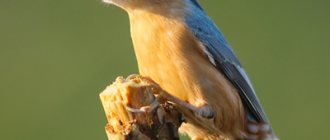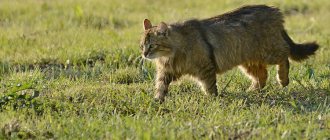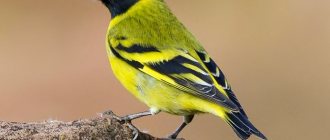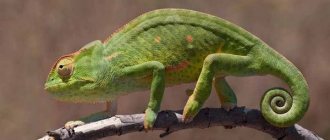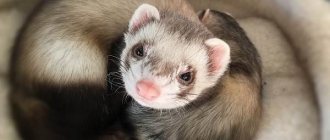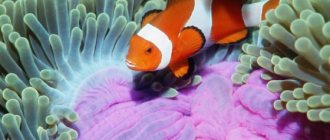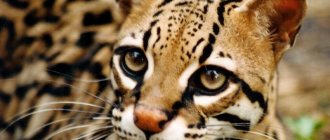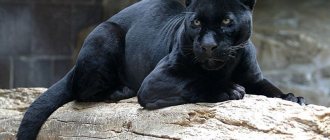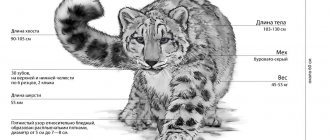16 June40128reptiles or reptilesaspidsblack mambadangerous animalssnakes
Who is the black mamba? Surely everyone has heard this exotic name. The black mamba is the most poisonous snake in Africa from the Aspid family. Also, the black mamba snake is one of the most dangerous animals both in Africa and in the world. In this article you will find a description and photo of the black mamba, and you will also be able to learn a lot of new and interesting things about this poisonous and dangerous snake.
The danger of viper for humans
The Levant viper is one of the most dangerous species of snakes for humans and livestock.
In moments of danger, this reptile can throw forward a distance equal to its body. Even experienced snake catchers have more than once become victims of Levantine vipers. Due to its muscular, massive body, the viper is very difficult to hold in your hands. It is not recommended to hold it by the head - trying to free its head, the snake begins to make sharp jerks, the weight of the reptile's body in motion exceeds the strength of human hands. Getting bitten by a viper is most likely by catching it and holding it with your hands. There are many known cases of a viper biting a catcher.
In terms of toxicity, the venom of the viper is not much weaker than that of the cobra. When bitten, about 50 mg of poison enters the victim's body. In most cases, the victim dies.
The fact is that Levant vipers do not tolerate the movement of a large object near them. The snake attacks humans and cattle without warning or visible danger. The viper simply attacks objects larger than itself. Without revealing itself in any way, the viper retreats after the attack. It is almost impossible to detect it before the attack - the color blends in with the environment. The behavior of hiding in the foliage and sitting motionless makes the viper absolutely invisible.
Poisonous viper snakes are very dangerous - within half an hour after being bitten, a person begins to feel sick, experience headaches and dizziness. In most cases, the bite results in death.
The intensity of the viper's venom depends on how deeply the poisonous teeth penetrate the skin, the location of the bite on the body and the volume of toxic saliva injected. The physical condition of the bitten person also plays a role.
What to do if you are bitten by a viper?
The main and effective measure to help with a viper bite is the administration of anti-snake serum. Half the dose is administered in three to four injections above the bite site. The remaining serum is injected into the scapular area (if the bite was in the arm) or buttock (if the bite was in the leg). It makes sense to administer the serum no later than an hour after the bite.
First of all, you need to suck out the blood from the wound, immediately spitting. The venom of snakes is partially destroyed by saliva, and a person cannot be poisoned by it, even if he has bad teeth. You should squeeze or suck out the blood for no longer than 5-8 minutes. After this, it is recommended to make a lotion from a weak solution of potassium permanganate, vinegar or soda.
The bitten limb should be immobilized as completely as possible. The victim is given plenty of fluids (tea, ayran, water). But the most important thing is to get the victim to the hospital as quickly as possible.
With timely assistance, the victim usually recovers the next day.
Antigyurza serum is used to treat those bitten by viper. It began to be produced in the USSR in the 1930s - first in Tashkent, then in Baku and Frunze (now Bishkek). Antigyurza serum is not produced in Russia; it must be purchased abroad. Serum "Antigyurza" helps with the bite of viper, efa and vipers. She is polyvalent. But it is rightly believed that it is not advisable to use serum for viper bites.
A Kazan man who miraculously survived a mamba bite talks about his luck
This African snake is very poisonous. At the same time, they were able to bring the victim back to life even without an antidote. Ekaterina Ivanova will tell you how this was done
Timur Shopovalov hides his face. Concerned about the mental health of his neighbors. They don’t even suspect who lives through the wall. The home-grown herpetologist has ten snakes in his collection. There are cobras and even a green mamba. Its bite is deadly. And so, the owner did not please her in some way.
The exotic lover assures that it is his own fault. Violated safety regulations. After the attack, I was not at a loss. He provided first aid to himself. I even had to cut out a piece of leather.
“I enlarged the wound, bled and went to the ambulance station,” said Timur
Doctors gathered a whole council, because in Russia there is no antidote and it is not clear how to treat it. We studied the literature. The forecast is disappointing. Internal organs fail one after another... The patient was connected to a ventilator. The blood was put on filtration. On the verge of life and death, Shapovalov spent three days in intensive care.
“Given that the snake is rare and extremely toxic, we decided to put the patient into medicinal sleep,” said Aliya Nasibulina, a toxicologist at City Clinical Hospital No. 7.
This unique case will probably be included in textbooks. Experts do not believe that this is even possible. Vladimir Cherlin at one time also kept poisonous pets at home. For example, a doctor of biological sciences brought a cobra from a business trip. But he received a fatal bite at work. The scientist was almost sent to the next world by a rattlesnake.
“This was the first time a snake bit me in a zoo in St. Petersburg. The hospitals didn’t know how to provide assistance at all,” says Doctor of Biological Sciences Vladimir Cherlin.
We tried everything we could. It took almost a year for treatment.
Reproduction
2-3 weeks after wintering, the mating season of vipers begins. At this time, “tournament” fights take place between males, which never end in death. Raising the upper part of the body and intertwining, the rivals try to press each other to the ground and at the same time hiss menacingly. The defeated male retreats, and the female, who was watching the fight from the side, crawls to the winner. The mating season is short, ending in about a week.
The common viper is an ovoviviparous snake. The number of eggs in the oviduct ranges from 5 to 18, depending on the age and habitat conditions of the snake. After about 3 months (late July - early August), the female gives birth to an average of 8-12 cubs. In the first days of their life, young snakes are inactive and feed on the yolk remaining in the body. By the way, the bites of newborn vipers are already poisonous.
After a few days, the cubs begin their first molt, and after it ends, they crawl around the territory in search of food. They feed mainly on insects, spiders, earthworms, etc. Young individuals molt quite often in the future - 1-2 times a month. They grow slowly. Females become sexually mature only at 4-5 years of age, males a year earlier.
Enemies
The enemies of the common viper are the same as those of other species of snakes. They are attacked by birds of prey, for example, buzzard, short-tailed snake eagle, and owl. They often become prey for foxes, hedgehogs, badgers, and ferrets.
Lifespan
Previously, it was believed that common vipers in natural conditions live no more than 14-15 years. However, long-term observations of tagged snakes of this species have shown that the age of some males in nature exceeds 20, and some females - 30 years.
And not only poisonous ones
But there are also snakes in Africa that are not poisonous. They become favorite pets of enthusiastic terrarium keepers. For example, the African aurora house snake from the family of false snakes. Amazing olive-green scales with a golden stripe along the entire length and a fancy ornament on the head become a true decoration. An almost meter-long reptile, unpretentious in maintenance, but at the same time amazingly beautiful.
Another non-venomous snake that is very interesting to watch is the African egg snake or common egg eater. Its length is a little more than a meter, it has a very beautiful light-colored body with pronounced ornaments. This snake will slowly swallow the entire egg in your terrarium. This action will take no more than half an hour. During which you will not leave the terrarium, watching this African snake.
Nutrition and behavioral characteristics
The western snake attacks during daylight hours. When active, it can also go hunting at night. Although she is a hunter snake, she is very shy. In case of a threat to life, she prefers to hide in the thicket.
If disturbed, the green mamba will begin to defend itself and attack. The most dangerous enemy of the green mamba is the mongoose, which can easily deal with it.
Important! The western snake is very fast and never warns of its attack, like other snakes, but rushes at the victim sharply and instantly. You can't tell from her behavior that she's preparing to attack.
She chooses prey of a size that she can swallow, although in a dangerous situation she will attack a victim larger than herself. The reptile poses a particular danger when harvesting mango fruits and tea leaves, because it is completely invisible in the green thicket.
The diet of the green mamba is:
- rodents;
- birds;
- bird eggs;
- reptiles;
- toads;
- rats;
- proteins;
- lizards.
On the ground, the green mamba can only be seen after chasing prey or while basking in the sun's rays. The behavior of this reptile is active, sharp, and nervous. This snake is very dynamic.
Learn how to keep pythons as pets: royal, reticulated, tiger.
Nutrition of the black mamba
About the black mamba, we can definitely say that this snake perfectly navigates the surrounding space equally well both in the dark and in the daytime. Therefore, she can go hunting whenever she pleases.
Its diet includes a huge number of all kinds of warm-blooded representatives of the animal world from squirrels, various rodents and birds to bats. Occasionally, some species of reptiles become its prey. The black mamba snake also feeds on frogs, although in exceptional cases, preferring other food to them.
These snakes hunt in approximately the same way: first they quietly sneak up on their prey, then bite it and crawl to the side in anticipation of its death. In the event that the concentration of poison was not sufficient for a quick lethal outcome, they can crawl out of cover to bite again.
As mentioned above, these representatives of reptiles are record holders among other snakes in terms of speed of movement, so it is very difficult for the victim to hide from them.
Features and habitat of the black mamba
The size of the black mamba is generally considered to be the largest among other species of this genus. Perhaps this is why it is least adapted for living in trees and can most often be found among sparse thickets of bushes.
Adults reach a length of up to three meters, although isolated cases have been recorded when the length of some specimens exceeded four and a half meters. During movement, this snake is capable of reaching speeds above eleven kilometers per hour, but on a flat surface the speed of its throws can reach twenty kilometers per hour.
The color of adult representatives of this species most often ranges from dark brown to black, although there are some individuals that have a rather variegated color. When young, the color of these snakes is usually less intense and ranges from off-white to light brown.
The black mamba lives primarily in areas from Somalia to Senegal and from South-West Africa to Ethiopia. Also distributed in South Sudan, Tanzania, Kenya, Namibia, Botswana, Zimbabwe and the Democratic Republic of the Congo.
Since it is not adapted to life in trees, it is practically impossible to meet it in tropical rain jungles. Its main habitat is slopes strewn with stones, river valleys, savannas and sparse forests with small thickets of various shrubs.
Since most of the lands where representatives of the genus Dendroaspis previously lived are today occupied by humans, the black mamba is forced to settle near small villages and towns.
One of the places where this snake likes to be located is reed thickets, where, in fact, the majority of its attacks on humans occur. Also quite often, representatives of this genus inhabit abandoned termite mounds, crevices and tree hollows located at a relatively low altitude.
What is it, “Black Death”?
African peoples are so frightened by the ferocity and aggressiveness of the snake that they try not to say its name out loud. They believe that she can take revenge, because she does not warn the enemy about her attack, but strikes with lightning speed. The characteristic cut of her mouth resembles a smile. The lethal dose of poison for humans is 15 mg; with one bite, up to 400 mg are released, and she can make several of them.
The size of the reptile is the largest in the Mamba genus. Its body length reaches three meters; there were individuals with a body length of four and a half meters! Body weight can vary from two to three kilograms.
The color of the snake is not black at all; the mamba itself is dark olive in color; towards the tip of the tail the color becomes darker. This reptile is the owner of a black mouth, in honor of which the name of this species appeared. Many see the outline of a coffin in the open mouth. A third of the head is occupied by glands that are connected by ducts to the fangs. Its teeth are up to 23 mm long and have a folding design. The poison paralyzes the victim, destroying the nervous system. It contains large amounts of neurotoxins, cardiotoxins and dendrotoxins. Caliciseptin causes suffocation in the victim, followed by cardiac arrest. Before attacking, it rises, opens its mouth and quickly strikes, most often to the head.
Where does the black mamba snake live and how does the most dangerous snake in Africa live?
The black mamba snake lives in Central, Eastern and Southern Africa, preferring semi-arid areas. The black mamba mainly lives in savannas and woodlands. The black mamba snake rarely climbs trees and bushes, mainly leading a terrestrial lifestyle. This dangerous snake of Africa has a large distribution area. The black mamba is found in northeastern Democratic Republic of Congo, South Sudan, southern Ethiopia, Eritrea, Somalia, Kenya, eastern Uganda, Tanzania, Burundi and Rwanda. In southern Africa, the black mamba snake lives in Mozambique, Swaziland, Malawi, Zambia, Zimbabwe, Botswana, Namibia, southern Angola and KwaZulu-Natal. This is the wide range of one of the most dangerous snakes in Africa.
Compared to other mambas, this one is least adapted for life in trees. Therefore, the poisonous black mamba mainly lives on the ground among shrubby vegetation. To bask in the sun, the black mamba snake can climb a tree or bush, but still prefers to be on the ground most of the time. Sometimes the black mamba lives in hollow trees, abandoned termite mounds and empty burrows.
The black mamba also lives on rocky slopes and in river valleys with fallen trees. The black mamba snake prefers to build long-term nests for living. Africa's most dangerous snake does not live in deserts or dense tropical forests. As a rule, the black mamba snake lives no higher than 1 km above sea level. But in Zambia, the black mamba is found at an altitude of 1.5 km above sea level, and in Kenya up to 1.8 km.
Despite the fact that the black mamba is the most dangerous and poisonous snake in Africa, even it has enemies. The main enemies of the black mamba are some birds of prey that hunt it. First of all, these are black and brown snake eaters; the black mamba snake most often becomes their victim. Another enemy of the black mamba is the needle snake, which has an innate immunity to the venoms of all African snakes. Also dangerous for the black mamba are mongooses, which sometimes hunt it and deftly avoid attacks, and also have acquired immunity from the bite of the black mamba.
What does a black mamba snake look like?
The black mamba is a very poisonous and dangerous snake in Africa. The black mamba looks very scary. The size of the black mamba makes it the second largest venomous snake after the king cobra. The length of the black mamba can reach up to 4 meters, but on average its size is 2.5-3 meters. The black mamba snake is one of the fastest in the world. The speed of the black mamba over short distances can exceed 11 km/h.
Despite its name, the black mamba does not look black at all. The black mamba snake acquired this unusual name because of the ink coloring of its mouth. The body color of the black mamba varies from dark olive to grayish brown, with a beautiful metallic sheen. The tail part looks darker than the main color, as it has darker scales. At the same time, the ventral side of the poisonous black mamba is dirty white or light brown. Young individuals are somewhat lighter than older ones. The color of the black mamba serves as good camouflage and changes depending on its habitat.
The black mamba looks like a slender snake, but among other mambas it is the largest. The black mamba snake weighs on average 1.5 kg. The black mamba's mouth has teeth that are 6.5 mm long. Through them she injects her poison during a bite. The black mamba's mouth has a peculiar cut. Because of this, the black mamba snake looks smiling, but do not be fooled by the friendliness of this poisonous snake of Africa.
Hunting and habitat
This reptile lives and hunts in open forests or thickets of bushes. Nests can be found:
- in tree hollows;
- in thickets of thick grass;
- in dead wood, under piles of dry branches;
- at the base of dry bushes.
Having a long body, about three meters, this snake occupies a leading place in the list of the largest snakes in the world. There are oral evidence of meetings with representatives of this species, four and a half meters long, but there is no documentary evidence of these facts. It is not difficult for these snakes to climb a tree, so they often hunt birds and destroy nests. In addition, the mamba's usual food is small rodents: jerboas, mice, squirrels, and so on.
The venom of this type of snake deserves special mention. The glands that produce it are huge in size relative to the snake’s head, occupying almost half the volume of the skull. This reptile is able to produce 400 mg of poison at a time, despite the fact that the lethal dose for an adult is 15-20 mg. The toxic effect is determined by its ability to quickly destroy the nervous system, interfering with breathing and cardiac activity. A person's death occurs within 3-4 hours if the bite is on a limb and after 15 minutes if the head or neck is affected.
The reassuring fact is that there is a completely effective (in 99% of cases) antivenom that should be administered immediately after the bite. Therefore, people traveling to places where these dangerous reptiles may live are advised to always have an antidote with them.
A black mamba, a photo of which is best studied in advance, attacks without warning; the victim hears neither hissing nor any other sounds. Before an attack, the snake rises on its tail, which poses a particular danger to humans, increasing the area of possible damage. When hunting rodents, the reptile crawls to the side after biting, waiting for the victim to die. A large supply of venom allows her to bite the animal again if necessary.
The black mamba is one of the few snakes that can pursue a prey for a long time: it reaches speeds of up to 20 km/h, which is a record among snakes. This reptile is always mobile; it does not fall into a stupor in order to digest food, unlike, for example, a boa constrictor.
https://youtube.com/watch?v=bcz9sEdmDSc
Appearance
The black mamba (Dendroaspis polylepis) is one of the most dangerous, largest, fastest and most aggressive snakes in the world. It reaches a length of 2.4–3 meters, although some specimens grow up to 4.5 meters. This snake got its name because of the black coloring of the inner cavity of its mouth. The black mamba can move at speeds of up to 11.3 km/h, and during short bursts on flat terrain it can reach speeds of about 20 km/h, which is the maximum for snakes. Thanks to this, she can not wait for the victim in ambush, but actively pursue it. The black mamba has an aggressive character and often attacks first. Leaning on its tail, the snake raises the front part of its body and throws itself, aiming at the body or head, instantly delivering a bite.
Who does the black mamba kill?
The black mamba snake has a bad reputation and in Africa local residents shudder when they hear its name. On the continent, the snake is respected, revered and greatly feared. And not in vain, because local residents talk about the black mamba as a symbol of death, even the name of the snake in their language means “black death”. In areas of Africa where this snake is common, there are a lot of myths and legends about the black mamba.
The black mamba is feared because it is very poisonous and fast. The black mamba snake is very mobile and agile; it silently glides along the ground with its head held high. The Guinness Book of World Records lists the black mamba as the fastest snake in the world, as a black mamba's speed of 11 km/h is common. However, there are also unsubstantiated legends about the increase in the speed abilities of this snake.
Despite its far from peaceful nature, the most poisonous snake, the black mamba, still tries to avoid contact when meeting a person. She freezes to remain unnoticed and tries to sneak away unnoticed. In most cases, the black mamba attacks only when it is caught by surprise or cornered. If contact cannot be avoided, the black mamba snake becomes aggressive, but it never hisses. The black mamba rises, leaning on its tail and opens its mouth wide; this pose is of a warning nature. After which the black mamba makes a series of lightning-fast throws and instantly inflicts a bite on the body or face. It happens that a black mamba snake can bite on the move, when trying to hide, but choosing the wrong direction towards the one who disturbed it. In such cases, a person does not immediately discover that he has become a victim of a black mamba bite. But after some time, various symptoms of poisoning appear.
The black mamba snake is very dangerous, the main danger is the poison of the black mamba. The bite of a black mamba is fatal. Fortunately, there is now an antidote. The venom of the black mamba is highly toxic and contains neurotoxins; without an antidote, paralysis and respiratory arrest occur. Death can occur within an hour after the bite, as the black mamba injects a lot of poison.
The black mamba feeds on small animals. The black mamba kills a variety of rodents, bats and birds. The most dangerous snake in Africa hunts during daylight hours, but even at night it can navigate no worse than during the day. Despite its speed abilities, usually the black mamba will attack from an ambush, in which it can wait, hiding for a very long time.
The black mamba snake prefers to ambush in the same place. Body coloring perfectly camouflages it and allows it to remain unnoticed. As soon as the prey comes into view, the black mamba makes a lightning-fast lunge and bites the victim. If one bite is not enough and the animal attempts to escape, it will chase it and inflict new bites until the prey dies from the effects of the poison. The black mamba digests the prey it eats in 8-10 hours.
Black mamba venom contains fast-acting neurotoxins. In one bite, the black mamba injects 100-120 mg of poison, while for an adult the lethal dose is only 10-15 mg. In 100% of cases, without the introduction of an antidote, a person will die.
After a black mamba bite, a person feels a burning pain, and in its place a tumor forms, necrosis is possible. Then digestive system disorders begin (unusual taste in the mouth, abdominal pain, nausea, vomiting, diarrhea). The next stage is the onset of progressive peripheral paralysis and, without the introduction of an antidote, death occurs from respiratory failure. Therefore, if you have been bitten by a black mamba, you should not hesitate to administer the antidote.
Character and lifestyle of the black mamba
The black mamba is a poisonous snake , and its difference from other reptiles that are dangerous to humans is its incredibly aggressive behavior. There are often cases when she is the first to attack, without waiting for the immediate threat posed by people.
Raising the upper part of her body and placing support on her tail, she makes a rapid release towards her victim, biting her in a split second and not allowing her to come to her senses. Often, before attacking a person, it opens its frightening black mouth wide, which can frighten even people with strong nerves.
It is believed that the dose of poison that can be fatal starts from fifteen milligrams, but in literally one bite of a black mamba a person can receive an amount ten to twenty times higher than this.
If a person is bitten by this most dangerous snake, he needs to be given an antidote within four hours, but if the bite falls directly on the face, then after just fifteen to twenty minutes he can die from paralysis.
The snake is named black not for its body color, but for its black mouth.
The venom of the black mamba contains a huge amount of fast-acting neurotoxins, as well as caliciseptin, which is incredibly dangerous for the cardio system, causing not only muscle stupor and destruction of the nervous system, but also suffocation along with cardiac arrest.
If an antidote is not administered, death occurs in one hundred percent of cases. There are rumors among the people that one such snake struck several cattle and horses at a time.
Today, special polyvalent serums have been developed that, if administered in a timely manner, can neutralize the poison; therefore, if a black mamba is bitten, urgent medical intervention is extremely necessary. Despite all their aggressiveness, these snakes are not so often the first to attack people, except in the case of self-defense.
Most often, they simply try to freeze in place or avoid direct contact. If the bite does occur, the person’s body temperature rapidly rises and he begins to have an intense fever, so it is best not to meet it face to face, limiting yourself to viewing photos of the black mamba on the Internet or reading reviews about the black mamba on the World Wide Web.
Antitoxin against snake venom
At the moment, the production of antitoxin is quite expensive. To create it, venom is first squeezed out of a snake (spider or insect), then it is diluted and injected into a horse, sheep or duck
.
Next, the response of the immune system is expected, as a result of which antibodies are produced against the active molecules of the poison. These antibodies are then produced in the animal's blood and are used to combat poisoning.
“When people see what I do, they usually swear or ask if I'm going to die. The photographs prove that I am immune. This is the only way people can believe in this, as well as in the fact that the way to independently develop immunity really works
“, says the American.
“It takes a very high level of mental effort to pull yourself together and allow yourself to be bitten. Injecting yourself with poison is one thing, but allowing yourself to be bitten by a poisonous snake is a completely different matter.
“, he explains.
Description
The poisonous representative of the family prefers to live in Africa and nearby areas. Her external data screams that the meeting could end sadly. Its size characteristics place the mamba in second place after the cobra in terms of danger. Individuals can grow up to 4 m in length, but, as a rule, much smaller representatives of 3 m are found. This reptile moves quickly and can reach speeds of up to 12 km/h. Therefore, in the event of a collision, it is quite difficult to avoid danger. Despite the fact that the mamba was nicknamed black, its body color is not that dark. The name of the individual was given due to the special coloring of the oral cavity; this area is black and intimidating when the snake is under attack. The mamba itself is pigmented olive, greenish-brown, and may be gray-brown. Some representatives of the species have a metallic sheen. The tail section is much darker than the rest of the body. The scales in this area are dark olive or so. The ventral part is whitish, dirty, sometimes beige with brown spots. The young are much lighter than the adult generation. Due to their specific color, these reptiles are conveniently camouflaged in forests and other natural environments, so in the event of a collision, it is not immediately possible to understand what happened. This snake is not as dense as other reptiles. She is thin, rather slender. However, among all the other mambas it is considered quite large. As for the weight category, individuals grow up to 1.5 kg in weight. The mouth contains sharp teeth that extend almost 7 mm. in length. It is thanks to the fangs that the victim’s body is filled with poison during a collision. When a reptile attacks, it appears as if the individual is smiling
But you shouldn’t expect leniency from her; it’s important to remember about the toxicity and danger.
horned viper - description, where it lives, features
Mamba black
- home
- Articles
- Encyclopedia of Animal Species
- Snakes
- Mamba black
- Content
- Classification
- general information
- Habitat
- Description
- Nutrition
- Reproduction
- Content
- Additionally
- Sources
The black mamba is a member of the genus Mambas (Dendroaspis). The species is widespread throughout the African continent (from South Africa to Somalia). Despite the fact that this species is not considered arboreal, the black mamba often lives in hollows and crowns of trees, in abandoned termite mounds. The average body length is from 2.5 to 3 meters, although there are references to specimens that reach more than 4 meters in length. Adults are olive green, taupe, dark olive, or metallic gray. Slightly variegated colors are also found. Based on the color variations, it becomes clear that the snake got its name for a different reason. And this reason is the coloring of the inside of her mouth.
Classification Kingdom: Animals Type: Chordata Subtype: Vertebrates Class: Reptiles Order: Squamate Suborder: Snakes Family: Asps Genus: Mambas Species: Black mamba - Dendroaspis polylepis
General information The genus Mambas (Dendroaspis) is a genus of venomous snakes in the family Slatidae, which includes five species of snakes common to sub-Saharan Africa. These are thin-tailed, slender arboreal snakes with a graceful head. Most often they are painted green, which harmonizes wonderfully with tree foliage, which actually provides the snake with excellent camouflage among the leaves and trees. On the lower and upper jaws of the mamba, the front teeth are long and thin, they help to hold the prey in weight. They feed mainly on rodents, small birds and lizards. Representatives of this species have extremely strong poison. So strong that a mamba bite for a person can be fatal within half an hour after the bite.
Habitat The black mamba is distributed in the territory from Senegal to Somalia and from Ethiopia to South-West Africa. However, it does not penetrate into the tropical rain forests of the Congo Basin. It is less adapted than other snakes to life in trees, so it usually stays among sparse tree or shrub vegetation. Due to the fact that humans occupied most of the territories in which this species lived for agricultural needs, the snake often settles on agricultural lands, for example, among reed beds. Sometimes you can see a mamba climbing to the top of the reeds to bask in the sun. By the way, it is in such areas that the bulk of mamba attacks on humans occur. The percentage also increases because most fields in Africa are cultivated by hand. Statistics reflect this - about 20 thousand people die every year from the bite of this snake.
Description The black mamba is the largest species of the mamba genus. At the same time, it is less adapted than other mambas to live in trees, so it is most often found among sparse bushes. This is one of the most fearless and dangerous snakes on the African continent. This is truly a sight not for the faint of heart - to see in front of you a black mamba that hisses loudly and opens its mouth so wide that its black throat is visible, and even makes threatening throws in your direction. This large snake reaches a length of 2.5 – 3 meters; individual specimens have been recorded reaching up to 4.5 meters in length. True, most likely snakes that reach such sizes are extremely rare, which casts doubt on the reliability of these data. The black mamba can move at a speed of up to 11 km/h, and with short throws on flat terrain it can reach a speed of 16-19 km/h. The average length of a black mamba is from 240 to 300 cm. If you look at it from above, the snake’s head resembles a coffin. Adults are black or dark brown on top; the ventral side is light brown or off-white. There are also individuals with slightly variegated colors. In young individuals, a grayish or olive color predominates, but as the snake gets older, the color changes. But one should not be surprised at the discrepancy between the name of the species and its color - the black mamba is so named because of the black coloring of the inner cavity of the mouth. At the front of the snake's mouth are two large, venomous teeth. As for non-poisonous teeth, they are present on both jaws. It chooses abandoned termite mounds, hollows or tree crowns for its habitat, although this snake is not considered arboreal. She uses her den for a long time. In times of danger, it tries to escape to its home, while developing a fairly high speed. The venom of the black mamba has an extremely strong neurotoxic effect. In one bite, the black mamba injects up to 400 mg of poison - for comparison: the lethal dose for an adult is 10-15 mg. The venom of this snake can kill a person in 4 hours if the bite was made on the finger or heel. But if a snake bites a person in the face, then death from paralysis can occur much faster - in about twenty minutes. There have been cases in history when the incredible bloodthirstiness of the black mamba was described. Some said that one mamba killed three horses at a time, others spoke of five bulls. This snake's venom contains fast-acting neurotoxins and cardiotoxins, including caliciseptin. Its poison paralyzes muscles and destroys the nervous system. The result is paralysis, suffocation, and cardiac arrest. Without immediate administration of an antidote, the fatal outcome is 100%. Although the composition of a snake's venom varies depending on where it lives, there is a very good anti-snake polyvalent serum developed by SAIMR (South African Institute of Medical Research). The good news is that black mamba bites on people are quite rare, but they pose a serious danger to life. Therefore, qualified and, most importantly, fast medical care is a very important factor - in 99 percent of cases, black mamba bites do not pose a risk to health.
Diet The black mamba is a very active hunter. It feeds mainly on warm-blooded animals: small rodents, birds, squirrels, and can sometimes feast on some reptiles, although this happens extremely rarely. Usually she bites her prey once or twice (this fact has given rise to the myth that the mamba always inflicts several bites on a person), then crawls away to allow the poison to act, although it happens that she holds her prey while biting.
Reproduction Mating in mambas occurs in late spring - early summer. During the mating season, males start battles for the right to mate with the female. Weaving into a knot, they try to pin each other to the ground and exchange headbutts. However, they do not use their poison in fights. The weaker male loosens his grip and crawls away. The winner does not pursue his former rival, but mates with a female who has come to his territory. After mating, the male returns to his nest, and the female lays 12 to 17 eggs in her den. The incubation period lasts 10-40 days. Young individuals hatch from 40 to 60 cm in length, becoming independent from the moment they are born. They are capable of catching prey the size of a rat. Young mambas grow very quickly and within a year reach 2 meters in length.
Contents Black mamba is bred in special nurseries, where from time to time poison is taken to make serum and other medicines. Due to its bad character and full use of its physical capabilities, the black mamba is not kept in the collections of terrariumists, although it is possible that there are fearless people who keep this species at home. You can find black mamba in the zoo's terrariums. Experts consider the black mamba to be very interesting to observe and study.
Additionally, the Black Mamba is included in the Top 20 most poisonous snakes on the planet, and is also listed in the Guinness Book of Records as the snake that reaches the highest speed - up to 20 km/h. Dendroaspis is translated from Latin as “tree snake.” There are many myths about the black mamba on the African continent. They say that this snake is capable of chasing a person for many miles in order to bite him. Or there is a belief that every person who enters a building where a black mamba lives will definitely be bitten. This is of course a big exaggeration. This snake is not that aggressive. There is also an opinion that mambas live in inseparable married couples. And if you happen to kill one snake, the second one will definitely take revenge for it. Therefore, if an African happens to kill a mamba near his home, he will certainly drag it along the ground for several kilometers in order to lead the “avenger” away from his home. It is likely that this belief arose after the following incident. The man who killed the female black mamba decided to play a prank on his wife and brought the snake's corpse home. The fact is that the female was killed during the mating season, and the male, eager for mating, found the female’s corpse using pheromones. When the male got into the house, he bit the first person who got in his way - the woman. Despite the threat and danger that the black mamba poses, it also has natural enemies. This snake is most afraid of mongooses. These nimble animals successfully hunt mambas. Moreover, mamba venom does not affect mongooses. True, most often they kill young snakes, preferring not to get involved with adult, strong individuals. And another enemy of the mamba, the wild boar, is tough on both the mongoose and the black mamba. This snake has superiority in speed of movement. At short distances, this snake can reach speeds of up to 20 km per hour. It is also included in the Top 20 among the most poisonous snakes on our planet - the black mamba has the strongest neurotoxic venom. In the collections of terrarium enthusiasts, the black mamba can be found extremely rarely. This snake has a very nasty character, and it uses its physical capabilities to the fullest.
Sources https://ru.wikipedia.org https://big-snake.narod.ru https://africa-predators.ru https://www.luthierscruise.com https://zmeya.siteedit.ru/ https www.crazy-zoologist.livejournal.com
Health to you and your pets!
© 2021 Team “ZOOVET” We are always happy to help you! 24-hour consultation: +7 Make an appointment [email protected]
Return to list
Characteristics
- The individuals in question do not have the best reputation even in their native Africa. When local residents hear about such a snake, they shudder. On such a continent, this individual is revered, respected and feared. Among the locals, the black mamba is a symbol of death.
- There are certain areas in Africa where the population of the individuals in question greatly predominates. This is where many myths and legends arose about such a snake. People are afraid of the black mamba due to the fact that individuals are one of the fastest and most dangerous reptiles.
- The presented individual has agility and mobility. A characteristic feature is that such a snake can glide quickly and silently along the ground. At the same time, the individual’s head is raised. In addition, while moving, the snake moves at its usual speed of 12 km/h.
- In addition, local residents like to exaggerate a little in legends; they say that such reptiles can reach incredible speeds. Therefore, there is no way for a person to escape from it. In fact, despite all the fairy tales and not the best character, when meeting a person, snakes try to avoid contact.
- When an individual notices people, it freezes. At the first opportunity, she tries to quickly crawl away. The black mamba can only attack if you drive it into a corner or leave no other choice. If you don't give the snake a chance to escape, it will become aggressive. It is worth noting that the individual does not hiss.
- Nevertheless, at first the reptile tries to warn the offender so that he retreats. To do this, it rests on its tail and takes a vertical stance. The snake opens its mouth wide and waits. If the person does not immediately retreat, the mamba delivers several quick and deadly throws to the face or body.
- In rare cases, when a snake is trying to crawl away and a person crosses its path, it can attack right on the move. Because of this, the victim does not even immediately understand what happened. He became an unwitting victim of the most dangerous snake in the world. After some time, the first symptoms of the bite will begin to appear.
- Do not forget that the individuals in question are very dangerous. Their main weapon is deadly poison. If the individual in question bites a person, it will be fatal to him. However, do not be upset ahead of time; there is an antidote for such cases.
- The problem is that you need to act very quickly. The person dies within 1 hour due to paralysis and respiratory arrest. As for the natural diet of such snakes, they often attack birds, mice and other rodents. Shows activity during the day.
In this material we have studied all the features affecting the most dangerous individuals. Despite their poisonousness, mambas have enemies who are naturally immune to the poison of this reptile. Snakes are afraid of mongooses and some individuals from the order of their own kind. Partly for this reason, it cannot be said that their existence is without threats. They lead a bushy lifestyle and develop high speed of movement.
indigo snake - description, where it lives, features
How to avoid an attack?
It is imperative to follow several rules to avoid meeting with this representative of reptiles. Firstly, do not approach the black mamba, this will be seen as a threat and an attack will follow. Secondly, you need to avoid places where the reptile can settle. Most often these are thickets of bushes, reeds, and large accumulations of rotten brushwood.
Thirdly, be sure to stock up on antidote if you plan to visit the habitats of these snakes. Don't forget to take it with you on walks of any length. This type of reptile can crawl out to hunt day and night.
However, there is an animal that is able to enter into a battle with a black mamba and win it! Its name is mongoose. He has resistance to poison. The snake-eating eagle and the needle snake, which is immune to toxins, can also cope with this snake.
If the attack could not be avoided, urgent medical attention is needed. If the serum is administered in time, it manages to neutralize the poison. When poisoned, the victim’s temperature rises very quickly, a fever begins, the bite site swells, and tissue dies locally. Statistics show that in 10-15 percent of cases, timely first aid does not help and the person dies.
Belcher
The winner in terms of toxicity is a close relative of the Australian taipan, which is called cruel or ferocious because of its quarrelsome and frantic disposition. A single dose of 400 mg can kill 100 people. The danger of the substance is 10 times greater than the venom of a rattlesnake and 50 times greater than that of a cobra. To our great joy, this creature leads a secretive existence, so no deaths were recorded.
It is reassuring that the individual is peaceful and does not hunt people. There are stories about fishermen who caught her in a net along with fish, or about tourists who decided to hold a beautiful snake in their hands, but even then she did not use her advantage, but made a fictitious bite without using a secret.
The consequences of a poisonous snake attack depend on the area affected, the weight of the person, timely assistance and concomitant diseases. The fact that their toxin is widely used in medicine speaks in favor of reptiles. By taking it away, people are already killing reptiles, because they spend enormous amounts of energy to produce poison.
